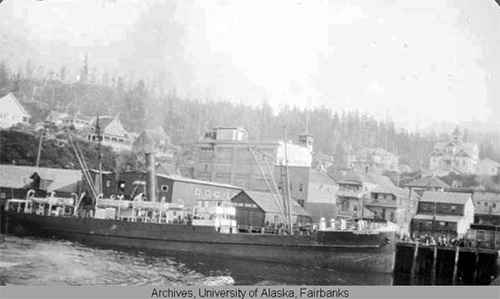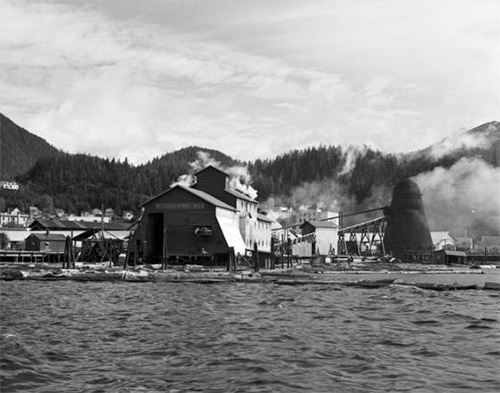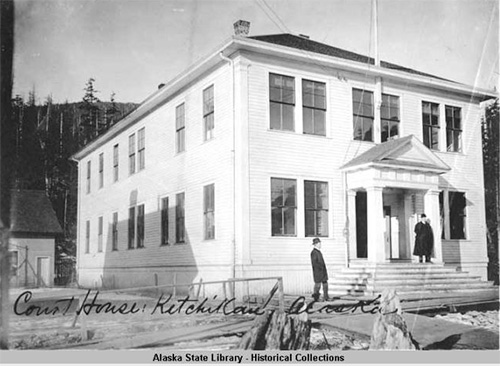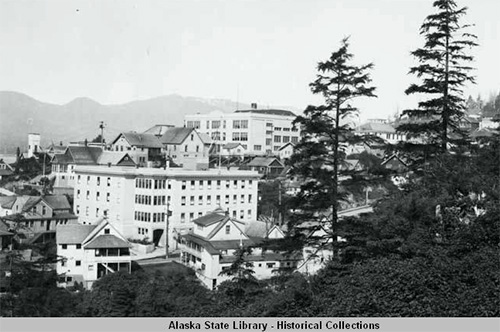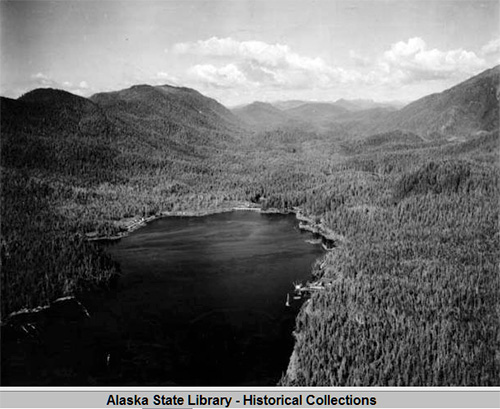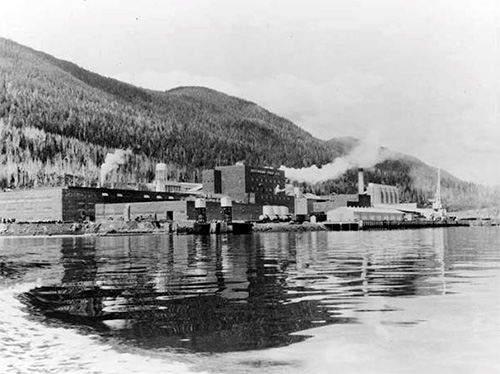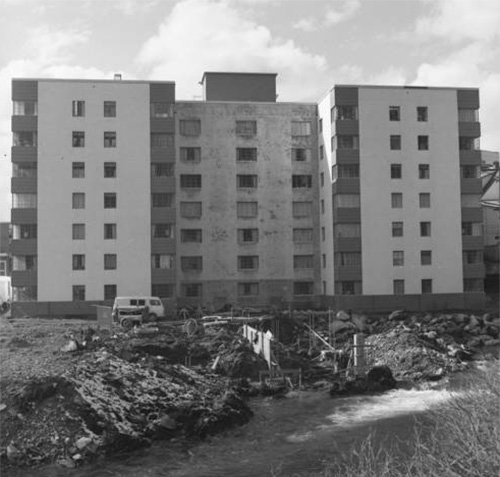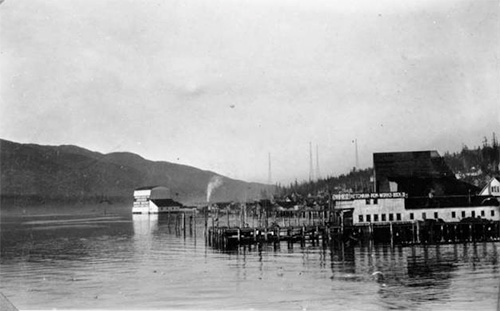
Ketchikan: A town of few 'highrises'In the First City, buildings grew outward rather than upwardBy DAVE KIFFER
September 04, 2017
But that doesn't mean that Ketchikan hasn't had its share of prominently sized buildings over its 130 years along Tongass Narrows. Photos from the mid 1890s show a large warehouse on the Clark-Martin dock, likely the storage area for the goods that were beginning to flow into the growing community, as well as the barrels of salted salmon that were beginning to flow out.
That building set the trend for Ketchikan's buildings being more horizontal than vertical. Cannery lines called for long, relatively narrow buildings and soon the small town on the water had a number of docks with long buildings extending out on pilings because there was little flat land inland. Canneries and cold storages like Sunny Point, Whitney Fidalgo and NEFCO had buildings that were more than a hundred feet long, but rarely more than two stories high. Even the Ketchikan Cold Storage, located where the lot next to Tongass Dock Store is now, was only three stories high, although it was nearly 50 feet high at its peak.
Early photos also show a number of two story buildings in Ketchikan's downtown, a pattern that still exists today, although a few three story ones sprouted up in the 1920s. Those photos also show the early Main School and the courthouse prominently located on hills just behind downtown. With its cupolas and dormers, the school building was likely 2 1/2 stories. One of the tallest structures in the early photos was a 40-foot tower at the fire station on Mill Street, which was likely used for hose storage. Another prominent feature early on was the 35-foot beehive sawdust burner that soared above Ketchikan Spruce Mill for many years, often lending a plume of black smoke to the horizon. The spire from St. John's Church at more than 30 feet was also prominent in early town photos.
Because fire was such a concern in the early city of wooden docks, streets and buildings, Ketchikan became one of the first Alaskan cities with concrete buildings, but even those buildings were rarely more than two stories. Two exceptions were the three story brick building that housed the NBA bank and professional offices for many years and the concrete Tongass store that was 3 1/2 stories high. In the 1920s, the new Main School and White Cliff School were three-story concrete structures. Several three story hotels, including the Ingersoll, Revilla. Gilmore, Pioneer and Knickerbocker were also built during the years when Ketchikan was the largest community in the state. In the early 1930s, the Federal government build a six story court house/jail/office building next to Thomas Basin. And in the early 1940s, the four story Ketchikan hospital was built at the corner of Park and Bawden.
But Ketchikan didn't get its first real "skyscrapers" until the community expansion that occurred when the Ketchikan Pulp Company arrived in the early 1950s. The pulp mill itself had a number of large buildings made out of distractive red bricks that were shipped in. Once again, many of the largest buildings were used to store product, including the large chip silos. The silos themselves were a little more than 110 feet tall, while two "scrubbers" on the facility boilers were just a hair over 130 feet tall and the tallest structures at the pulp mill. In keeping with the Ketchikan trend of building out rather than up, the largest building on the mill site was the water filter plant which was around 85,000 square feet, according to planning records. For comparison sake, the Ketchikan Walmart store is 72,000 square feet and the Plaza Mall is 90,000 square feet but on two stories. One of the more prominent pulp mill related structures is the Connell Lake Dam which is 78 feet high and approximately 600 feet long.
During the pulp mill boom a five story building, the Mary Frances building near Ketchikan Creek, was built to house many of the early mill managers. The workers who built the mill were housed in two 11 story concrete buildings on Ketchikan's West End, which in those days were referred to colloquially as the Wingren and the Austin. Now they are condominium buildings called the Marine View and the Tongass Towers. Both were slightly over 100 feet tall and they remained Ketchikan's tallest "buildings" for more than half a century until expansion at the Ketchikan Shipyard created a construction hall that topped out at 105 feet.
A new high school on Ketchikan's West End which opened in 1954 had one of the largest footprints of any Ketchikan building, but with changes in construction laws it was kept to two stories. When that school was rebuilt in the early 1990s, it retained much of its original footprint. In the 1960s, two large supermarkets, Wingren and Log Cabin, were built in the West End. A decade later the Plaza Mall was built adjoining what had been the Wingren Supermarket. Also, in the early 1960s, the hospital moved from its four story building downtown to a three story building on the West End, with, once again, a more expansive footprint.
Also during the 1960s there were also several plans to build taller buildings in Ketchikan's downtown. Most notably was a plan, announced to much fanfare in the early 1970s, that would have built a 20 story hotel on the Ingersoll block, but like many Ketchikan proposals, it went nowhere. In more recent years, the community has built a new library, a fire station, expanded hospital, and a recreation/aquatic center, as well as new schools, that would all qualify as large buildings in other communities. Once again, the general layout has been horizontal rather than vertical, which seems unusual since Ketchikan generally has limited flat land. Often the expanded site prep necessary in an area where the ground is either muskeg or granite adds significant cost when any large project is considered. But Ketchikan continues to general expand outward, rather than upward. In Ketchikan itself, the tallest structures have always been the radio towers on Inman Hill and near Bar Harbor on the West End.
At one point there were three towers in the West End, but two of them, 200 plus feet high, in additional to the tower on Inman Hill, collapsed during the infamous 1968 Thanksgiving Day hurricane in which local wind gauges blew down at 130 mph. The Inman Hill tower was rebuilt at a height of 260 feet. A White Alice Communications Tower near Bar Harbor survived the storm and continues to stand tall today as Ketchikan's tallest structure at 330 feet above the ground. Interestingly enough the tallest structures in the area were ones that few residents ever saw or knew much about. For nearly 40 years, the US Coast Guard operated a Loran C station at Shoal Cove, 22 miles northeast of Ketchikan near Carroll Inlet. There were three 695-foot towers on that site until the Coast Guard closed the station nearly seven years ago. The towers were imploded when the site closed down. For nearly four decades, from the 1940s to 1970s, the US Coast Guard also operated a radio station near Point Higgins some 13 miles north of Ketchikan. Several of the towers at that station were in excess of 100 feet tall.
On the Web:
Contact Dave at dave@sitnews.us Dave Kiffer ©2017 Representations of fact and opinions in comments posted are solely those of the individual posters and do not represent the opinions of Sitnews.
|
||||||||||
